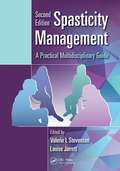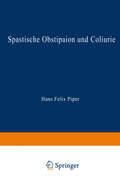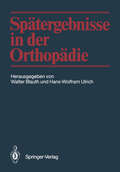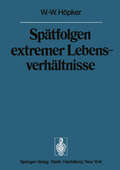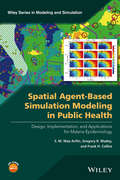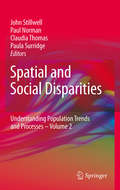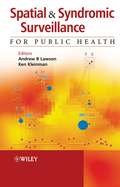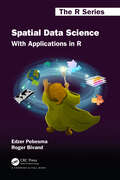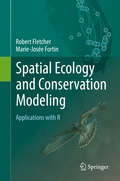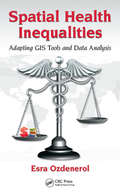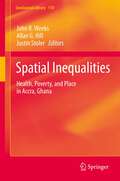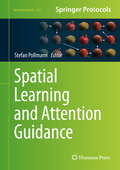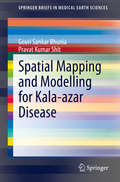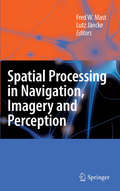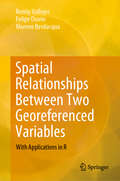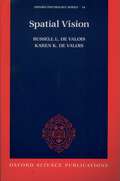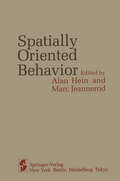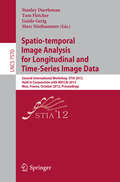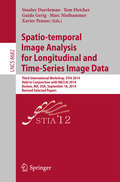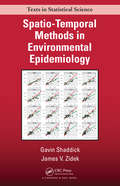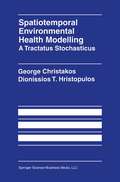- Table View
- List View
Spasticity Management: A Practical Multidisciplinary Guide, Second Edition
by Valerie L. Stevenson Louise JarrettSpasticity is a common symptom that arises in a wide range of neurological conditions. Unfortunately, a poor understanding and inadequate management of spasticity often results in it having a greater impact on patients than necessary. Using a multidisciplinary approach, Spasticity Management: A Practical Multidisciplinary Guide provides the essenti
Spasticity Management: A Practical Multidisciplinary Guide, Second Edition
by Valerie L. Stevenson Louise JarrettSpasticity is a common symptom that arises in a wide range of neurological conditions. Unfortunately, a poor understanding and inadequate management of spasticity often results in it having a greater impact on patients than necessary. Using a multidisciplinary approach, Spasticity Management: A Practical Multidisciplinary Guide provides the essenti
Spastische Obstipaion und Coliurie
by Hans-Felix PiperDieser Buchtitel ist Teil des Digitalisierungsprojekts Springer Book Archives mit Publikationen, die seit den Anfängen des Verlags von 1842 erschienen sind. Der Verlag stellt mit diesem Archiv Quellen für die historische wie auch die disziplingeschichtliche Forschung zur Verfügung, die jeweils im historischen Kontext betrachtet werden müssen. Dieser Titel erschien in der Zeit vor 1945 und wird daher in seiner zeittypischen politisch-ideologischen Ausrichtung vom Verlag nicht beworben.
Spätfolgen extremer Lebensverhältnisse: Veröffentlichungen aus der Forschungsstelle für Theoretische Pathologie der Heidelberger Akademie der Wissenschaften (Sitzungsberichte der Heidelberger Akademie der Wissenschaften #1974 / 1974)
by W.-W. HöpkerSpatial Agent-Based Simulation Modeling in Public Health: Design, Implementation, and Applications for Malaria Epidemiology (Wiley Series in Modeling and Simulation)
by S. M. Arifin Gregory R. Madey Frank H. CollinsPresents an overview of the complex biological systems used within a global public health setting and features a focus on malaria analysis Bridging the gap between agent-based modeling and simulation (ABMS) and geographic information systems (GIS), Spatial Agent-Based Simulation Modeling in Public Health: Design, Implementation, and Applications for Malaria Epidemiology provides a useful introduction to the development of agent-based models (ABMs) by following a conceptual and biological core model of Anopheles gambiae for malaria epidemiology. Using spatial ABMs, the book includes mosquito (vector) control interventions and GIS as two example applications of ABMs, as well as a brief description of epidemiology modeling. In addition, the authors discuss how to most effectively integrate spatial ABMs with a GIS. The book concludes with a combination of knowledge from entomological, epidemiological, simulation-based, and geo-spatial domains in order to identify and analyze relationships between various transmission variables of the disease. Spatial Agent-Based Simulation Modeling in Public Health: Design, Implementation, and Applications for Malaria Epidemiology also features: Location-specific mosquito abundance maps that play an important role in malaria control activities by guiding future resource allocation for malaria control and identifying hotspots for further investigation Discussions on the best modeling practices in an effort to achieve improved efficacy, cost-effectiveness, ecological soundness, and sustainability of vector control for malaria An overview of the various ABMs, GIS, and spatial statistical methods used in entomological and epidemiological studies, as well as the model malaria study A companion website with computer source code and flowcharts of the spatial ABM and a landscape generator tool that can simulate landscapes with varying spatial heterogeneity of different types of resources including aquatic habitats and houses Spatial Agent-Based Simulation Modeling in Public Health: Design, Implementation, and Applications for Malaria Epidemiology is an excellent reference for professionals such as modeling and simulation experts, GIS experts, spatial analysts, mathematicians, statisticians, epidemiologists, health policy makers, as well as researchers and scientists who use, manage, or analyze infectious disease data and/or infectious disease-related projects. The book is also ideal for graduate-level courses in modeling and simulation, bioinformatics, biostatistics, public health and policy, and epidemiology.
Spatial Agent-Based Simulation Modeling in Public Health: Design, Implementation, and Applications for Malaria Epidemiology (Wiley Series in Modeling and Simulation)
by S. M. Arifin Gregory R. Madey Frank H. CollinsPresents an overview of the complex biological systems used within a global public health setting and features a focus on malaria analysis Bridging the gap between agent-based modeling and simulation (ABMS) and geographic information systems (GIS), Spatial Agent-Based Simulation Modeling in Public Health: Design, Implementation, and Applications for Malaria Epidemiology provides a useful introduction to the development of agent-based models (ABMs) by following a conceptual and biological core model of Anopheles gambiae for malaria epidemiology. Using spatial ABMs, the book includes mosquito (vector) control interventions and GIS as two example applications of ABMs, as well as a brief description of epidemiology modeling. In addition, the authors discuss how to most effectively integrate spatial ABMs with a GIS. The book concludes with a combination of knowledge from entomological, epidemiological, simulation-based, and geo-spatial domains in order to identify and analyze relationships between various transmission variables of the disease. Spatial Agent-Based Simulation Modeling in Public Health: Design, Implementation, and Applications for Malaria Epidemiology also features: Location-specific mosquito abundance maps that play an important role in malaria control activities by guiding future resource allocation for malaria control and identifying hotspots for further investigation Discussions on the best modeling practices in an effort to achieve improved efficacy, cost-effectiveness, ecological soundness, and sustainability of vector control for malaria An overview of the various ABMs, GIS, and spatial statistical methods used in entomological and epidemiological studies, as well as the model malaria study A companion website with computer source code and flowcharts of the spatial ABM and a landscape generator tool that can simulate landscapes with varying spatial heterogeneity of different types of resources including aquatic habitats and houses Spatial Agent-Based Simulation Modeling in Public Health: Design, Implementation, and Applications for Malaria Epidemiology is an excellent reference for professionals such as modeling and simulation experts, GIS experts, spatial analysts, mathematicians, statisticians, epidemiologists, health policy makers, as well as researchers and scientists who use, manage, or analyze infectious disease data and/or infectious disease-related projects. The book is also ideal for graduate-level courses in modeling and simulation, bioinformatics, biostatistics, public health and policy, and epidemiology.
Spatial and Social Disparities (Understanding Population Trends and Processes #2)
by John Stillwell Paul Norman Claudia Thomas Paula SurridgeInequality is one of the major problems of the contemporary world. Significant geographical disparities exist within nations of the developed world, as well as between these countries and those referred to as the ‘South’ in the Bruntland Report. Issues of equity and deprivation must be addressed in view of sustainable development. However, before policymakers can remove the obstacles to a fairer world, it is essential to understand the nature of inequality, both in terms of its spatial and socio-demographic characteristics. This second volume in the series contains population studies that examine the disparities evident across geographical space in the UK and between different individuals or groups. Topics include demographic and social change, deprivation, happiness, cultural consumption, ethnicity, gender, employment, health, religion, education and social values. These topics and the relationships between them are explored using secondary data from censuses, surveys or administrative records. In volume 1 the findings of research on fertility, living arrangements, care and mobility are examined. Volume 3 will focus on ethnicity and integration.
Spatial and Syndromic Surveillance for Public Health
by Andrew B. Lawson Ken KleinmanFollowing the events of 9/11 and in the current world climate, there is increasing concern of the impact of potential bioterrorism attacks. Spatial surveillance systems are used to detect changes in public health data, and alert us to possible outbreaks of disease, either from natural resources or from bioterrorism attacks. Statistical methods play a key role in spatial surveillance, as they are used to identify changes in data, and build models of that data in order to make predictions about future activity. This book is the first to provide an overview of all the current key methods in spatial surveillance, and present them in an accessible form, suitable for the public health professional. It features an abundance of examples using real data, highlighting the practical application of the methodology. It is edited and authored by leading researchers and practitioners in spatial surveillance methods. Provides an overview of the current key methods in spatial surveillance of public health data. Includes coverage of both single and multiple disease surveillance. Covers all of the key topics, including syndromic surveillance, spatial cluster detection, and Bayesian data mining.
Spatial Data Science: With Applications in R (Chapman & Hall/CRC The R Series)
by Edzer Pebesma Roger BivandSpatial Data Science introduces fundamental aspects of spatial data that every data scientist should know before they start working with spatial data. These aspects include how geometries are represented, coordinate reference systems (projections, datums), the fact that the Earth is round and its consequences for analysis, and how attributes of geometries can relate to geometries. In the second part of the book, these concepts are illustrated with data science examples using the R language. In the third part, statistical modelling approaches are demonstrated using real world data examples. After reading this book, the reader will be well equipped to avoid a number of major spatial data analysis errors. The book gives a detailed explanation of the core spatial software packages for R: sf for simple feature access, and stars for raster and vector data cubes – array data with spatial and temporal dimensions. It also shows how geometrical operations change when going from a flat space to the surface of a sphere, which is what sf and stars use when coordinates are not projected (degrees longitude/latitude). Separate chapters detail a variety of plotting approaches for spatial maps using R, and different ways of handling very large vector or raster (imagery) datasets, locally, in databases, or in the cloud. The data used and all code examples are freely available online from https://r-spatial.org/book/. The solutions to the exercises can be found here: https://edzer.github.io/sdsr_exercises/.
Spatial Data Science: With Applications in R (Chapman & Hall/CRC The R Series)
by Edzer Pebesma Roger BivandSpatial Data Science introduces fundamental aspects of spatial data that every data scientist should know before they start working with spatial data. These aspects include how geometries are represented, coordinate reference systems (projections, datums), the fact that the Earth is round and its consequences for analysis, and how attributes of geometries can relate to geometries. In the second part of the book, these concepts are illustrated with data science examples using the R language. In the third part, statistical modelling approaches are demonstrated using real world data examples. After reading this book, the reader will be well equipped to avoid a number of major spatial data analysis errors. The book gives a detailed explanation of the core spatial software packages for R: sf for simple feature access, and stars for raster and vector data cubes – array data with spatial and temporal dimensions. It also shows how geometrical operations change when going from a flat space to the surface of a sphere, which is what sf and stars use when coordinates are not projected (degrees longitude/latitude). Separate chapters detail a variety of plotting approaches for spatial maps using R, and different ways of handling very large vector or raster (imagery) datasets, locally, in databases, or in the cloud. The data used and all code examples are freely available online from https://r-spatial.org/book/. The solutions to the exercises can be found here: https://edzer.github.io/sdsr_exercises/.
Spatial Ecology and Conservation Modeling: Applications with R
by Robert Fletcher Marie-Josée FortinThis book provides a foundation for modern applied ecology. Much of current ecology research and conservation addresses problems across landscapes and regions, focusing on spatial patterns and processes. This book is aimed at teaching fundamental concepts and focuses on learning-by-doing through the use of examples with the software R. It is intended to provide an entry-level, easily accessible foundation for students and practitioners interested in spatial ecology and conservation.
Spatial Health Inequalities: Adapting GIS Tools and Data Analysis
by Esra OzdenerolThe neighborhoods and the biophysical, political, and cultural environments all play a key role in affecting health outcomes of individuals. Unequal spatial distribution of resources such as clinics, hospitals, public transportation, fresh food markets, and schools could make some communities as a whole more vulnerable and less resilient to adverse health effects. This somber reality suggests that it is rather the question of "who you are depends upon where you are" and the fact that health inequality is both a people and a place concern. That is why health inequality needs to be investigated in a spatial setting to deepen our understanding of why and how some geographical areas experience poorer health than others. This book introduces how spatial context shapes health inequalities. Spatial Health Inequalities: Adapting GIS Tools and Data Analysis demonstrates the spatial health inequalities in six most important topics in environmental and public health, including food insecurity, birth health outcomes, infectious diseases, children’s lead poisoning, chronic diseases, and health care access. These are the topics that the author has done extensive research on and provides a detailed description of the topic from a global perspective. Each chapter identifies relevant data and data sources, discusses key literature on appropriate techniques, and then illustrates with real data with mapping and GIS techniques. This is a unique book for students, geographers, clinicians, health and research professionals and community members interested in applying GIS and spatial analysis to the study of health inequalities.
Spatial Health Inequalities: Adapting GIS Tools and Data Analysis
by Esra OzdenerolThe neighborhoods and the biophysical, political, and cultural environments all play a key role in affecting health outcomes of individuals. Unequal spatial distribution of resources such as clinics, hospitals, public transportation, fresh food markets, and schools could make some communities as a whole more vulnerable and less resilient to adverse health effects. This somber reality suggests that it is rather the question of "who you are depends upon where you are" and the fact that health inequality is both a people and a place concern. That is why health inequality needs to be investigated in a spatial setting to deepen our understanding of why and how some geographical areas experience poorer health than others. This book introduces how spatial context shapes health inequalities. Spatial Health Inequalities: Adapting GIS Tools and Data Analysis demonstrates the spatial health inequalities in six most important topics in environmental and public health, including food insecurity, birth health outcomes, infectious diseases, children’s lead poisoning, chronic diseases, and health care access. These are the topics that the author has done extensive research on and provides a detailed description of the topic from a global perspective. Each chapter identifies relevant data and data sources, discusses key literature on appropriate techniques, and then illustrates with real data with mapping and GIS techniques. This is a unique book for students, geographers, clinicians, health and research professionals and community members interested in applying GIS and spatial analysis to the study of health inequalities.
Spatial Inequalities: Health, Poverty, and Place in Accra, Ghana (GeoJournal Library #110)
by John R. Weeks, Allan G. Hill and Justin StolerThis book provides a fresh analysis of the demography, health and well-being of a major African city. It brings a range of disciplinary approaches to bear on the pressing topics of urban poverty, urban health inequalities and urban growth. The approach is primarily spatial and includes the integration of environmental information from satellites and other geospatial sources with social science and health survey data. The authors Ghanaians and outsiders, have worked to understand the urban dynamics in this burgeoning West African metropolis, with an emphasis on urban disparities in health and living standards. Few cities in the global South have been examined from so many different perspectives. Our analysis employs a wide range of GIScience methods, including analysis of remotely sensed imagery and spatial statistical analysis, applied to a wide range of data, including census, survey and health clinic data, all of which are supplemented by field work, including systematic social observation, focus groups, and key informant interviews. This book aims to explain and highlight the mix of methods, and the important findings that have been emerging from this research, with the goal of providing guidance and inspiration for others doing similar work in cities of other developing nations.
Spatial Learning and Attention Guidance (Neuromethods #151)
by Stefan PollmannThis volume looks at the latest research techniques to study the interaction of visual spatial learning and attention guidance with behavioral, psychophysiological, and imaging methods. Part One (behavioral methods) focuses on different paradigms of visual search like visual foraging and contextual cueing, and also methods like feature distribution analysis and search in virtual reality. Part Two (psychophysiological methods) integrates innovative uses of classical potential changes like the CDA and N2pc, with multivariate analysis methods and multi-method designs. Part Three (functional imaging) covers lesion-behavior mapping, retinotopic and grid cell mapping methods for human fMRI, as well as functional registration by hyperalignment and simultaneous eye-tracking and fMRI. In Neuromethods series style, chapters include the kind of detail and key advice from the specialists needed to get successful results in your laboratory.Cutting-edge and comprehensive, Spatial Learning and Attention Guidance is a valuable resource for all researchers and scientists who are interested in learning more about the relationship between attention and memory.
Spatial Mapping and Modelling for Kala-azar Disease (SpringerBriefs in Medical Earth Sciences)
by Gouri Sankar Bhunia Pravat Kumar ShitThis book addresses the current challenges in controlling Kala-azar disease (Visceral leishmaniasis) in India and other VL-endemic areas, and aims to develop and apply a geo-environmental risk model based on primary and secondary data with the aid of remote sensing and GIS technologies to assess and mitigate Kala-azar transmission. Through case studies carried out in India, the book provides insight into the relationship between geo-environmental variables and encroachments of Kala-azar, and identifies potential pathways for VL introduction to develop mitigation strategies using GIS and remote sensing technologies. The book critically assesses existing VL mitigation measures that do not adequately account for geo-environmental conditions, and analyzes the environmental factors that aid Kala-azar transmission using remote sensing, spatial statistics and data mining techniques. The book will be of interest to epidemiologists, researchers and practitioners using geospatial data practices to study disease transmission and associated monitoring technologies.
Spatial Processing in Navigation, Imagery and Perception
by Fred W. Mast Lutz JänckeThe processing of spatial information is an increasingly important topic, especially in recent few years, with new findings emerging from such diverse disciplines as cognitive neuroscience; cognitive psychology; sensorimotor integration; neuropsychology and neuroanatomy. Bringing together contributions from a group of internationally highly renowned researchers from across these disciplines, this book offers a state-of-the-art platform on which the latest developments in spatial processing are presented.
Spatial Relationships Between Two Georeferenced Variables: With Applications in R
by Ronny Vallejos Felipe Osorio Moreno BevilacquaThis book offers essential, systematic information on the assessment of the spatial association between two processes from a statistical standpoint. Divided into eight chapters, the book begins with preliminary concepts, mainly concerning spatial statistics. The following seven chapters focus on the methodologies needed to assess the correlation between two or more processes; from theory introduced 35 years ago, to techniques that have only recently been published. Furthermore, each chapter contains a section on R computations to explore how the methodology works with real data. References and a list of exercises are included at the end of each chapter. The assessment of the correlation between two spatial processes has been tackled from several different perspectives in a variety of applications fields. In particular, the problem of testing for the existence of spatial association between two georeferenced variables is relevant for posterior modeling and inference. One evident application in this context is the quantification of the spatial correlation between two images (processes defined on a rectangular grid in a two-dimensional space). From a statistical perspective, this problem can be handled via hypothesis testing, or by using extensions of the correlation coefficient. In an image-processing framework, these extensions can also be used to define similarity indices between images.
Spatial Vision (Oxford Psychology Series)
by Russell L. DeValois Karen K. DeValoisThis volume presents an integrated view of how we perceive the spatial relations in our visual world, covering anatomical, physiological, psychophysical, and perceptual aspects. The authors discuss the visual system primarily in terms of spatial frequency analysis using a linear systems approach. They review evidence supporting a local, patch-by-patch spatial frequency filtering of visual information rather than the global Fourier analysis other researchers have proposed. A separate chapter addresses the special issues surrounding color vision, and a brief, nonmathematical introduction to linear systems analysis is included for the uninitiated reader.
Spatio-temporal Image Analysis for Longitudinal and Time-Series Image Data: Second International Workshop, STIA 2012, Held in Conjunction with MICCAI 2012, Nice, France, October 1, 2012, Proceedings (Lecture Notes in Computer Science #7570)
by Stanley Durrleman Tom Fletcher Guido Gerig Marc NiethammerThis book constitutes the refereed proceedings of the Second International Workshop on Spatio-temporal Image Analysis for Longitudinal and Time-Series Image Data, STIA 2012, held in conjunction with MICCAI 2012 in Nice, France, in October 2012. The 13 papers presented in this volume were carefully reviewed and selected from 22 submissions. They are organized in topical sections named: longitudinal registration and transport; spatio-temporal analysis for shapes; spatio-temporal analysis under appearance changes; and spatio-temporal analysis for biology.
Spatio-temporal Image Analysis for Longitudinal and Time-Series Image Data: Third International Workshop, STIA 2014, Held in Conjunction with MICCAI 2014, Boston, MA, USA, September 18, 2014, Revised Selected Papers (Lecture Notes in Computer Science #8682)
by Stanley Durrleman Tom Fletcher Guido Gerig Marc Niethammer Xavier PennecThis book constitutes the thoroughly refereed post-conference proceedings of the Third International Workshop on Spatio-temporal Image Analysis for Longitudinal and Time-Series Image Data, STIA 2014, held in conjunction with MICCAI 2014 in Boston, MA, USA, in September 2014.The 7 papers presented in this volume were carefully reviewed and selected from 15 submissions. They are organized in topical sections named: longitudinal registration and shape modeling, longitudinal modeling, reconstruction from longitudinal data, and 4D image processing.
Spatio-Temporal Methods in Environmental Epidemiology (Chapman And Hall/crc Texts In Statistical Science Ser.)
by Gavin ShaddickTeaches Students How to Perform Spatio-Temporal Analyses within Epidemiological StudiesSpatio-Temporal Methods in Environmental Epidemiology is the first book of its kind to specifically address the interface between environmental epidemiology and spatio-temporal modeling. In response to the growing need for collaboration between statisticians and
Spatiotemporal Environmental Health Modelling: A Tractatus Stochasticus
by George Christakos Dionissios HristopulosSpatiotemporal Environmental Health Modelling: A Tractatus Stochasticus provides a holistic, conceptual and quantitative framework for Environmental Health Modelling in space-time. The holistic framework integrates two aspects of Environmental Health Science that have been previously treated separately: the environmental aspect, which involves the natural processes that bring about human exposure to harmful substances; and the health aspect, which focuses on the interactions of these substances with the human body. Some of the fundamental issues addressed in this work include variability, scale, uncertainty, and space-time connectivity. These topics are important in the characterization of natural systems and health processes. Spatiotemporal Environmental Health Modelling: A Tractatus Stochasticus explains why modern stochastics is the appropriate mechanical vehicle for addressing such issues in a rigorous way. In particular, modern stochastics incorporates concepts and methods from probability, classical statistics, geostatistics, statistical mechanics and field theory. The authors present a synthetic view of environmental health that embraces all of the various components and focuses on their mutual interactions. Spatiotemporal Environmental Health Modeling: A Tractatus Stochasticus includes new material on Bayesian maximum entropy estimation techniques and space-time random field estimation methods. The authors show why these methods have clear advantages over the classical geostatistical estimation procedures and how they can be used to provide accurate space-time maps of environmental health processes. Also included are expositions of diagrammatic perturbation and renormalization group analysis, which have not been previously discussed within the context of Environmental Health. Finally, the authors present stochastic indicators that can be used for large-scale characterization of contamination and investigations of health effects at the microscopic level. This book will be a useful reference to both researchers and practitioners of Environmental Health Sciences. It will appeal specifically to environmental engineers, geographers, geostatisticians, earth scientists, toxicologists, epidemiologists, pharmacologists, applied mathematicians, physicists and biologists.
